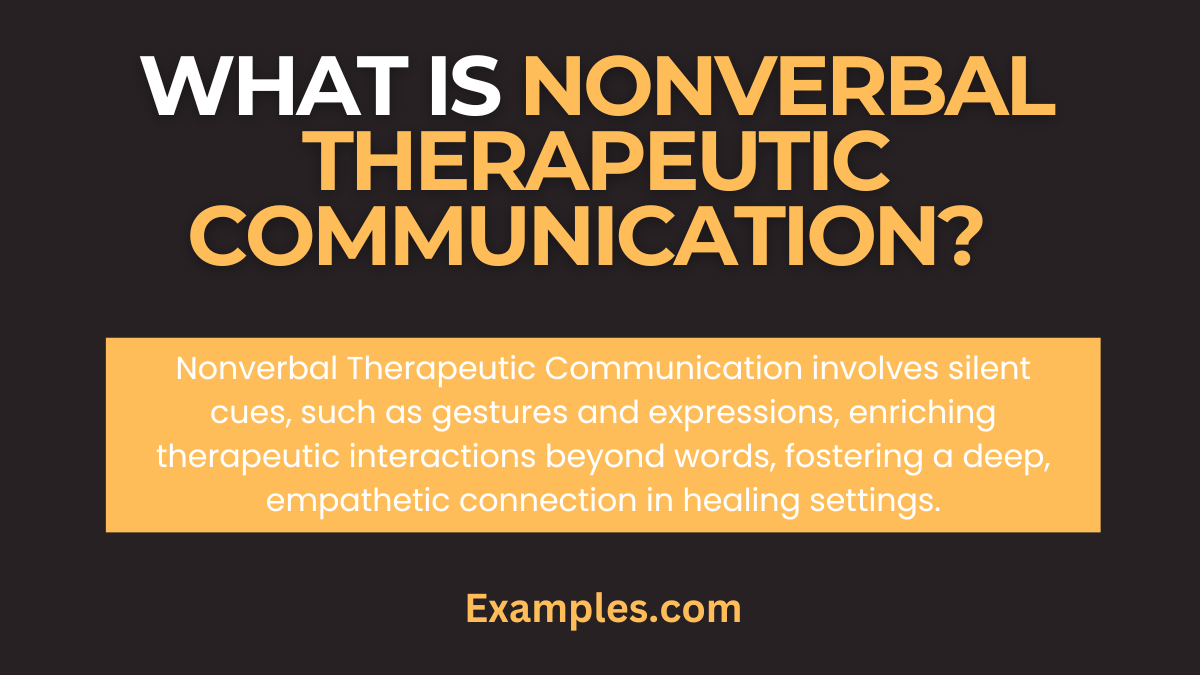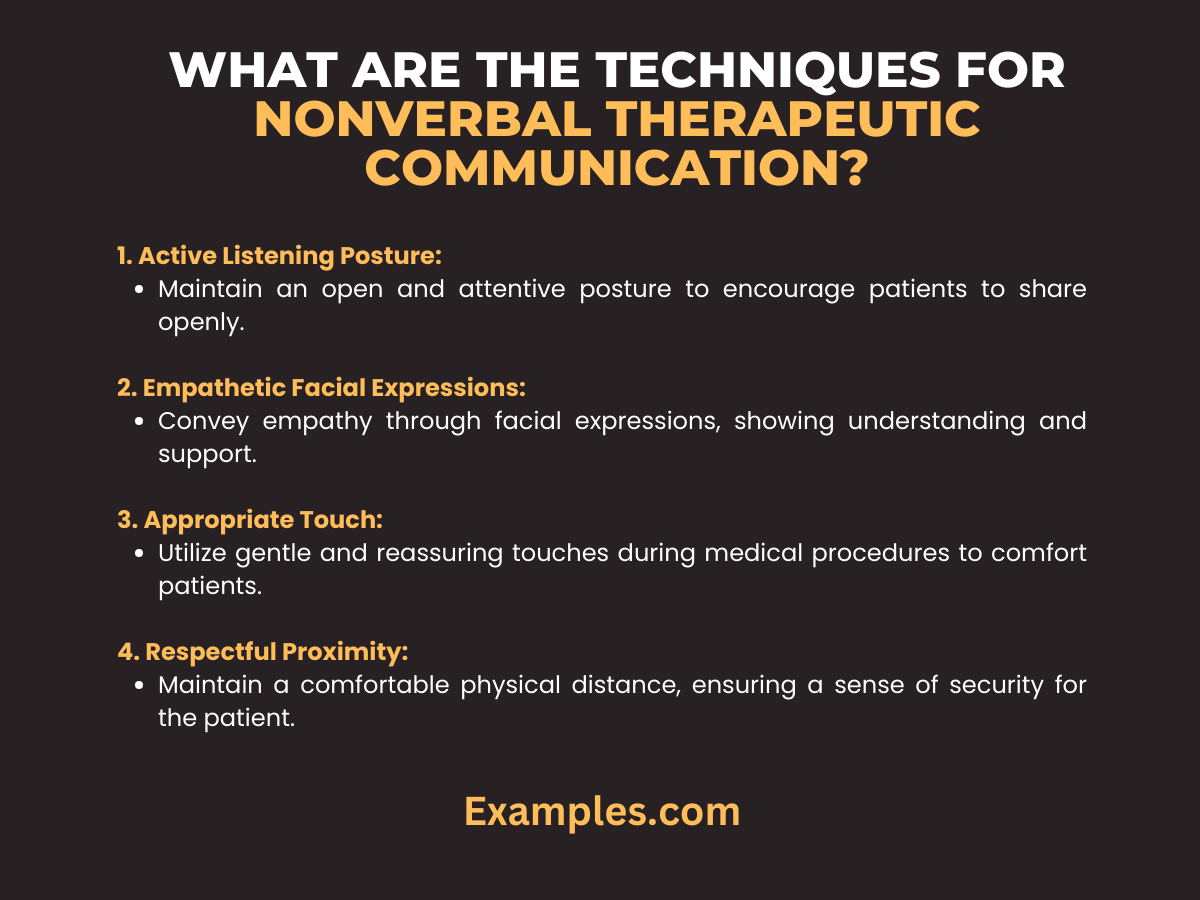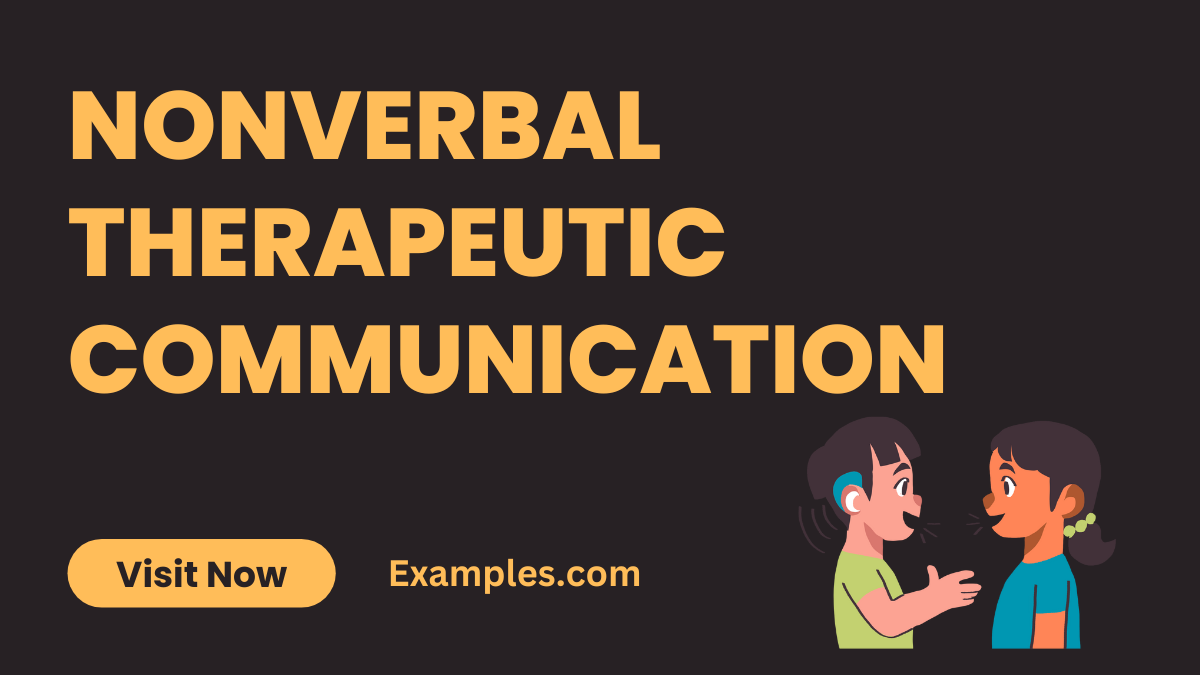Nonverbal Therapeutic Communication
Embark on a profound journey into Nonverbal Therapeutic Communication, an essential component of effective healing interactions. This comprehensive guide unravels the significance of unspoken cues, offering vivid examples to enrich your understanding. Explore the subtleties of nonverbal language, discover practical tips, and witness real-world communication examples that illuminate the power of silent connection in therapeutic relationships. Enhance your skills in therapeutic dialogue through the art of Nonverbal Therapeutic Communication Examples.
What is Nonverbal Therapeutic Communication?

Nonverbal Therapeutic Communication encompasses the subtle, unspoken cues exchanged in therapeutic interactions. It involves gestures, body language, and facial expressions, enriching the dialogue beyond words. This form of communication deepens understanding, fostering a connection that transcends verbal expression. In therapeutic settings, practitioners utilize nonverbal cues to convey empathy, support, and understanding, creating an environment where patients feel heard and valued. Nonverbal Therapeutic Communication plays a pivotal role in enhancing the healing process through silent but powerful expressions.
20 Nonverbal Therapeutic Communication Examples

Explore the richness of Nonverbal Therapeutic Communication through these 20 vivid examples. Each instance represents a unique way to convey empathy, support, and understanding, enhancing the therapeutic process through silent expressions.
- Warm Gestures:
Example: Extend a comforting hand, conveying reassurance and compassion. - Empathetic Eye Contact:
Example: Maintain prolonged eye contact to express genuine concern and connection. - Reflective Body Language:
Example: Mirror the patient’s posture, fostering a sense of shared understanding. - Soft Touch:
Example: Gently pat the patient’s shoulder, providing a soothing, supportive touch. - Mirroring Emotions:
Example: Reflect the patient’s emotions through your own facial expressions. - Space Awareness:
Example: Respect personal space, promoting a sense of security and comfort. - Nod of Understanding:
Example: Nod affirmatively to acknowledge and validate the patient’s feelings. - Facial Expressions:
Example: Use smiles and frowns to convey warmth, encouragement, or concern. - Pacing and Timing:
Example: Adjust your communication pace to match the patient’s, ensuring comfort. - Relaxed Posture:
Example: Maintain an open and relaxed posture, signaling approachability. - Tone of Voice:
Example: Speak with a calm and soothing tone, promoting a sense of safety. - Soothing Silence:
Example: Allow moments of silence for reflection, fostering a contemplative atmosphere. - Expressive Hand Movements:
Example: Use gentle hand gestures to emphasize key points and convey warmth. - Shared Laughter:
Example: Share a light-hearted moment to ease tension and create a positive connection. - Mirroring Breathing Patterns:
Example: Match your breathing to the patient’s rhythm, promoting a sense of unity. - Visual Aids:
Example: Utilize visual aids to enhance communication, catering to diverse learning styles. - Encouraging Head Nods:
Example: Nod affirmatively to encourage the patient to share their thoughts and feelings. - Respectful Posture Changes:
Example: Sit or stand at the patient’s eye level, establishing equality in the conversation. - Cultural Sensitivity:
Example: Adapt nonverbal cues to align with the patient’s cultural background, promoting inclusivity. - Focused Listening:
Example: Lean slightly forward, demonstrating attentiveness and active listening.
These Nonverbal Therapeutic Communication examples showcase the art of silent expression, enhancing therapeutic connections with sensitivity and empathy.
Nonverbal Therapeutic Communication Examples for Patients
In healthcare, Nonverbal Therapeutic Communication with patients is pivotal. Explore impactful examples that transcend words, fostering empathy and understanding. These silent expressions play a crucial role in creating a supportive environment, contributing to the overall well-being of patients.
- Comforting Touch:
Example: Embrace a patient’s hand, offering reassurance and demonstrating empathy. - Compassionate Facial Expressions:
Example: Wear a gentle smile to convey warmth and understanding during discussions. - Patient-Centered Proximity:
Example: Sit at eye level, ensuring a connection that promotes openness and trust. - Responsive Mirroring:
Example: Reflect a patient’s emotions through mirroring, validating their feelings without words. - Encouraging Gestures:
Example: Use encouraging nods to convey support, affirming the patient’s thoughts and concerns. - Therapeutic Silence:
Example: Allow periods of therapeutic silence, giving patients the space for reflection. - Respectful Space Awareness:
Example: Maintain respectful personal space, promoting a sense of security. - Attentive Body Language:
Example: Lean slightly forward, showcasing active listening and engagement. - Visual Aids for Clarity:
Example: Utilize visuals to enhance communication, ensuring clarity and understanding. - Tender Reassurance:
Example: Gently pat the patient’s shoulder, offering comfort and emotional support.
Nonverbal Therapeutic Communication Examples for Nurses
In nursing, nonverbal therapeutic communication is a nuanced skill vital for patient care. Nurses employ gestures, expressions, and body language to convey empathy and support, creating a healing atmosphere. Explore these examples showcasing the subtle yet impactful nonverbal cues nurses utilize to connect with patients and enhance their overall well-being.
- Gentle Touch during Procedures: Execute medical procedures with a gentle touch to reassure and comfort the patient. “I’ll be administering your injection now,” while offering a reassuring touch.
- Maintaining Eye Contact in Assessments: Sustain eye contact during patient assessments, fostering trust and engagement. “I’m here to understand your symptoms,” while maintaining focused eye contact.
- Empathetic Facial Expressions: Use empathetic facial expressions to convey understanding during difficult discussions. “I appreciate your concerns; let’s discuss your treatment options,” with a supportive facial expression.
- Active Listening Posture: Adopt an active listening posture to encourage patients to share their experiences openly. “Take your time; I’m here to listen,” with an attentive posture.
- Smile of Reassurance: Offer a warm smile to reassure patients, creating a positive and comforting environment. “Your progress is commendable; keep up the good work,” accompanied by a supportive smile.
- Adapting Communication Style: Adapt communication style to suit the patient’s preferences, promoting effective understanding. “Would you prefer a detailed explanation, or a brief overview of your treatment plan?” respecting individual communication preferences.
- Appropriate Physical Proximity: Maintain appropriate physical proximity to convey closeness without intrusion during discussions. “Let’s discuss your care plan; I’m right here to address any concerns,” with a comfortable proximity.
- Calm and Soothing Tone: Use a calm and soothing tone to deliver challenging information, promoting emotional well-being. “We’ll navigate this together; your health is our priority,” with a reassuring tone.
- Visual Aids for Clarity: Integrate visual aids to enhance communication, ensuring patients comprehend medical information. “Let’s review this diagram together to better understand your upcoming procedure,” utilizing visual aids.
- Acknowledging Patient’s Emotional State: Acknowledge the patient’s emotional state through nonverbal cues, offering support. “I sense this news is overwhelming; take your time, and we can discuss your concerns,” showing understanding through nonverbal cues.
Why is Nonverbal Communication Important in Therapy?
Nonverbal communication plays a pivotal role in therapeutic settings, enriching the therapeutic process in various ways. Here’s a concise overview of why nonverbal communication is crucial in therapy:
- Expressing Emotions: Nonverbal cues often convey emotions more accurately than words, allowing patients to express their feelings authentically.
- Building Trust: Nonverbal signals, such as maintaining eye contact and open body language, contribute to building trust between the therapist and the patient.
- Understanding Unspoken Concerns: Patients may hesitate to verbalize certain concerns; nonverbal cues aid therapists in comprehending unspoken issues.
- Fostering Connection: Nonverbal therapeutic communication fosters a deeper emotional connection between the therapist and the patient, enhancing the therapeutic relationship.
- Enhancing Empathy: Nonverbal cues, including facial expressions and gestures, facilitate therapists in demonstrating empathy and understanding.
- Cultural Sensitivity: Nonverbal communication is crucial for understanding cultural nuances, ensuring therapy is respectful and inclusive.
- Navigating Resistance: Nonverbal cues help therapists identify and address resistance or discomfort that may not be expressed verbally.
- Encouraging Openness: Creating a nonjudgmental environment through nonverbal signals encourages patients to open up and share more freely.
- Establishing Comfort: Nonverbal elements like tone of voice and physical proximity contribute to creating a comfortable and safe therapeutic space.
- Promoting Mindfulness: Therapists can utilize nonverbal techniques to guide patients toward mindfulness, promoting self-awareness and reflection.
Recognizing the importance of nonverbal communication in therapy enables therapists to create a more supportive and effective therapeutic environment.
What are the techniques for Nonverbal Therapeutic Communication?

Nonverbal therapeutic communication involves subtle techniques that enhance understanding and connection in therapeutic interactions. Employ these effective techniques to foster a healing atmosphere:
- Active Listening Posture:
- Maintain an open and attentive posture to encourage patients to share openly.
- Empathetic Facial Expressions:
- Convey empathy through facial expressions, showing understanding and support.
- Appropriate Touch:
- Utilize gentle and reassuring touches during medical procedures to comfort patients.
- Respectful Proximity:
- Maintain a comfortable physical distance, ensuring a sense of security for the patient.
- Mirroring Emotions:
- Reflect the patient’s emotions through your own facial expressions and body language.
Tips for Effective Nonverbal Therapeutic Communications?
Enhance the impact of nonverbal therapeutic communication with these practical tips:
- Cultural Sensitivity:
- Adapt nonverbal cues to align with the patient’s cultural background, promoting inclusivity.
- Mindful Silence:
- Use purposeful silence for reflection, allowing patients time to process information.
- Visual Aids:
- Integrate visual aids to enhance communication, catering to diverse learning styles.
- Adaptive Communication Styles:
- Tailor communication styles to suit individual patient preferences for effective understanding.
- Empathetic Tone:
- Deliver information with a calm and soothing tone to promote emotional well-being.
- Acknowledgment of Emotions:
- Recognize and acknowledge the patient’s emotional state through nonverbal cues.
- Collaborative Decision-Making:
- Encourage patient involvement through nonverbal cues in shared decision-making processes.
- Mirroring Breathing Patterns:
- Establish a sense of unity by matching your breathing to the patient’s rhythm.
- Respectful Nodding:
- Demonstrate active engagement through respectful nodding, conveying agreement and understanding.
- Encouraging Posture:
- Adopt an encouraging posture during discussions, promoting a positive and supportive environment.
In conclusion, mastering nonverbal therapeutic communication is a transformative skill in healthcare and beyond. Through empathetic gestures, active listening, and culturally sensitive cues, practitioners can create healing connections. This comprehensive guide provides insights into techniques and tips, empowering individuals to navigate diverse communication scenarios with compassion and effectiveness.



